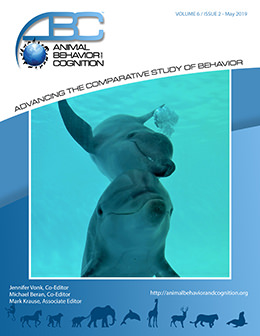Vol 6, Issue 2, May 2019
Social Behaviors Modulate Bottlenose Dolphins' (Tursiops truncatus) Breathing Rate
Citation
Serres, A., & Delfour, F. (2019). Social behaviors modulate bottlenose dolphins' (Tursiops truncatus) breathing rate. Animal Behavior and Cognition, 6(2), 127–140. https://doi.org/10.26451/abc.06.02.04.2019.
Abstract
Breathing frequency is a non-invasive physiological measure that brings valuable information on the bottlenose dolphins’ internal state and behaviors. When combined with behavioral observations, it helps to better understand and interpret relevant behaviors. The present study aimed to investigate some basic characteristics of breathing rate in nine dolphins (Tursiops truncatus) (e.g., age and sex effects) and to describe the modulation of the animals’ breathing frequency influenced by their simultaneously displayed activity (solitary play, social play, socio-sexual and agonistic behaviors) with a focus on social play that is thought to be a potential welfare indicator. Our results showed that young dolphins’ breathing frequency was higher than older ones’ and this rate was significantly higher when the dolphins were engaged in social play, socio-sexual and agonistic behaviors than when they were not involved in any of these interactions (e.g., resting or other behaviors). These social behaviors might be useful parameters to attribute a stressful or excitement state to the animals and more studies are needed to validate them as dolphin welfare indicators. Moreover, as breathing frequency does not allow to differentiate positive and negative stress in these animals, other physiological parameters should be measured.
Keywords
Breathing frequency, Social play, Bottlenose dolphin, Welfare, Respiration rate, Social behavior, Tursiops truncatus
